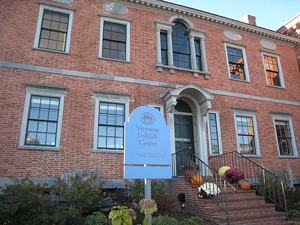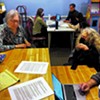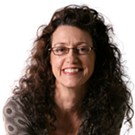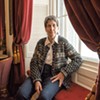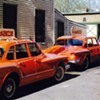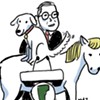Published November 7, 2007 at 5:29 p.m.
You don’t have to go to deer camp to hear Roy Hines talk about tracking a 10-point, 278-pound buck up a mountain and shooting it through the heart. No hunting license is required to listen to Gayle Streeter of Morrisville recall her first kill. Or to eavesdrop on Rochester Deputy Warden Cleo Johnson as he tells how he rescued a drowning fawn that subsequently became a pet.
Middlebury’s Vermont Folklife Center compiled the excerpted memories of nearly two-dozen hunters in an audio program called Deer Stories that wrapped last year. The series of 12 short segments — each running for three to five minutes — perfectly reflects the center’s mission of “preserving the voices and traditions of Vermont.”
The 23-year-old Vermont Folklife Center is more like a library than a museum: It’s the state’s de facto oral archive, a repository of more than 4000 hours of interviews and other audio material. And, like so many organizations charged with managing information in the Google era, it’s technologically challenged. Over the years, the nonprofit has mined its vast collections to create arts-and-crafts exhibits, children’s books, radio programs and apprentice opportunities. Now it’s determined to make accessing online audio files as easy as “Search,” “Roy Hines,” “Play.” That means “digitizing” the archive: converting the audio on every cassette, reel, record and other audio into a format that can be read by a computer.
Currently, if you want to hear Hines’ “Championship Buck” story, you have to go to the website of Public Radio Exchange, a nonprofit distributor of radio content, and sign up there. An email confirmation explains the subsequent log-on process. Only after jumping through those hoops can you listen in as the very elderly Hines, who has since passed away, recalls his surprise attack on the unsuspecting animal. In a thick Vermont brogue, he recalls, “Why, that was an old big buck. My gosh! He was laying down right there, right in plain sight, and he hadn’t even knew I was there.”
While it moves slowly into the Information Age, the Vermont Folklife Center did make some dramatic changes over the summer. It moved from Middlebury’s Court Street to a more highly trafficked spot on Main Street, where Route 125 turns west toward the college. The larger building, formerly owned by Steven Rockefeller, reflects the organization’s new priorities. The exhibition space is smaller than it was at the previous location and shares the first floor with the gift shop, which is doing a brisk walk-up business. The second floor holds a gallery for emerging artists that doubles as an electronic classroom. In an adjacent office, longtime Education Director Gregory Sharrow oversees a dizzying number of programs, from Youth Radio Vermont to a summer institute that introduces teachers to ethnographic field-research methods.
Sharrow reports that only a few, mostly elderly, people are still using tape recorders to conduct interviews in this “transitional” period. He’s more interested in talking about the larger “democratizing” effects of the digital revolution. “Now anyone can produce radio,” he enthuses. “You don’t have to have a studio space; you just need Pro Tools and a computer with some memory. It’s an opportunity for us to kind of open our process up to other people — kids, adults, whomever — so it isn’t just us doing the work. That’s, like, fabulous.”
Across the hall from Sharrow is the office of Brent Björkman. He’s the VFC’s first executive director since its founder, Jane Beck, retired last summer after 23 years on the job. He’s a gentle, ego-less man who describes his predecessor as a national role model in her field. “Everyone looked up to Jane,” he says, and to the innovative programming developed at VFC, which he describes as “a flagship folklife center.”
Over the course of her long career, Beck received awards from the American Folklore Society and the Vermont Council on the Arts. Her audio documentary on Vermonter Daisy Turner, “Journey’s End,” won a Peabody — one of the most coveted honors in broadcasting.
Björkman, who grew up in Minnesota, exhibits two characteristics of a trained folklorist: He listens well and tells a good story. Asked if it’s been daunting to take over for Beck, he relates an encounter with the barber who gave him his first haircut in Middlebury. “The barber, a man of few words, is clipping, clipping. Finally, about five minutes in, he says, ‘So, you live around here?’
“‘Well, actually, I just moved here.’”
Björkman pauses to convey the barber’s reticent manner.
“‘What do you do?’ he finally asked.
“‘I’m the new director at the new Folklife Center.’”
Björkman pauses again.
“‘Ah, Jane Beck, huh? Big shoes to fill.’
“I mean, it comes at me from every angle,” Björkman concludes with a chuckle.
Archivist Andy Kolovos rules the building’s lower level. He oversees an expanded “vault” — where the physical archives live — plus a new sound studio, a control room that doubles as a state-of-the-art audio lab, and the room that hosts the 2.5-terabyte file-storage server. He estimates 20 percent of the archive contents have been digitized so far. “It’s ‘on’ in a prototypical sense,” Kolovos says of the massive project, but virtual visitors won’t see any bells — or, more importantly, hear any whistles — until well into the new year.
There’s a lot of pressure on Kolovos, who is readying himself for the possible coincidence of two big upcoming events: the Folklife Center’s open house and the birth of his first child. But he’s happy to display his new, improved — and chilly — archive, with its big, heavy door and movable, space-saver stacks.
This space holds all the materials that have gone into the Folklife Center’s public programming. It’s got Beck’s extensive interviews with Daisy Turner, whose grandfather was a slave, along with Turner family photographs, film and a fiddling soundtrack provided by her nephew. Other boxes of raw research material shed light on the history of the Mad River Valley, Vermont general stores, contemporary farm life and dozens of other projects carried out by the center.
But it’s the items donated by other people, and local historical societies, that make a visitor strolling through the vault feel akin to a kid in a candy shop. “Lately we’ve gotten some really neat stuff,” Kolovos says, indicating boxes of audio recordings from a 1976 film called Last-Stand Farmer. To make his documentary, Richard Brick recorded hours and hours of interviews with Chelsea farmer Kenneth O’Donnell. Remarkably, notes Kolovos, the recording quality is “pristine. It’s like an in-depth personal study of this one person and this guy’s attitudes about life.”
Other archive residents are better known. Kolovos points out a pile of records by St. Albans big-band jazz leader Sterling Weed, who passed away two years ago at the age of 104. They’re aluminum-core acetate discs, so he’ll have to send them out to be digitized by a specialist: “Unless you know what you’re doing, you’ll destroy them,” Kolovos warns. He says the center also received “hundreds of cassette tapes for teaching students” from Weed. Kolovos won’t make any of the commercial recordings available online, for copyright reasons, but he says, “If it’s a recording of him, there’s no question we’re keeping it.”
Another treasure in the archive is folk musician Margaret MacArthur’s collection of old-time Vermont songs, along with “a lot of the Beaudoin Family stuff.” It has recordings from the Northeast Fiddlers Association — three decades’ worth. A stack of modern-looking CDs stands out: They’re Jim Lockridge’s Big Heavy World compilations. A forward-thinking guy, to be sure.
It’s not all music: The space holds audio artifacts from Thunder Road, knitters, auctioneers and South Asians living in Vermont. Before she died, Burlington historian Lilian Carlisle donated her radio shows to the VFC.
Kolovos gravitates to a small collection of old-fashioned records. It includes a few Vermont-centric ambient-sound albums: Apparently, people in the ’50s and ’60s used to groove to the sounds of trains, farms and birds. One of these albums is descriptively titled The Swamp in June.
Another shocker from the archives: It looks like Rusty “The Logger” DeWees had a country-bumpkin predecessor: Charles Ross Taggert. Comedian Francis Colburn must have been another popular act, on the Droll Yankees label, “considering how often his recordings turn up,” Kolovos observes.
The Folklife Center accepts almost everything it’s offered — even a collection of World War II lobby cards and Nazi trading cards. “It’s one of those things,” Kolovos says. “Someone heard we were involved in the Veterans History Project and had that stuff lying around. Better we have them than that they get sold to someone.”
Contributors are allowed to place conditions on their “donations,” whether they’ve granted an interview as part of a research project or are giving primary source materials to the collection. “That’s part of the deal,” Kolovos says. There’s no rule against odd disclaimers: “It can be as ‘out there’ as ‘No left-handed people on rainy Thursdays can read this with one eye closed.’”
No one’s likely to place such an absurd restriction on an item. But the archive does have secrets of a sort, items that “nobody can see for various reasons,” Kolovos says. A certain Abenaki video, for example, is off limits — anyone who wants to view it has to make a formal request and wait while a panel of the participants convenes to hand down a decision. Another party donated a slide show with the explicit direction that it never be made available online.
“They didn’t want it to be changed by someone else — made fun of, in this case,” Kolovos speculates.
Safeguarding people’s words, and history, brings with it a huge responsibility. “In the digital world, you can’t stop people from doing what they want with it.”
Folklorists are bound by an ethical code that may sound strange to a practicing journalist. They’re less interested in truth per se than in “how people perceive experience,” Kolovos explains, “whether or not their perceptions have anything to do with what I can objectively prove happened, or didn’t happen.”
Accordingly, folklorists view the people they interview, record and archive more as “collaborators” than as “sources.” Those collaborators have the final say on how they are portrayed.
Extending veto power to interviewees can slow the process of collecting oral history — as it did in the case of Deer Stories. Sharrow recalls how when he brought the hunters together to listen to the “final” program, they didn’t like certain material in the segments entitled “Taking a Life” and “Careful What You Shoot.” Sharrow had to remove two excerpts in each of the pieces that were “pretty graphic.” He says that, “though they were utterly true and perfectly representative of their experience,” the hunters felt they “would give too much ammunition to the enemy.”
Tree-huggers, that is.
The Vermont Folklife Center could use those hunters right about now to resurrect its annual game dinner, which once served up all manner of venison, elk, bear and moose around this time every year at the American Legion Hall. Most of the raw material came from Beck’s husband Horace, who was an avid hunter up until his death three years ago.
Kolovos isn’t ready for this particular tradition to be relegated to the archive. “We’re trying to reconstitute it. We’ve just got to find someone to supply the meat,” he says of his favorite Folklife Center event. Like the organization he works for, Kolovos is naturally attracted to events of ethnographic significance. Who says you can’t preserve cultural history — in a string of ones and zeroes — and also make it?
More By This Author
Speaking of...
-

A Multilayered Career Leads a Seasoned Chef to Middlebury’s Swift House Inn
Mar 12, 2024 -

Middlebury: What to See, Do and Eat During the Eclipse
Mar 6, 2024 -

Middlebury's Champlain Valley Creamery Marks 20 Years With a Milestone Cheese
Feb 27, 2024 -

A Program for Women Leaving Prison Struggles to Make the Grade at Middlebury
Dec 13, 2023 -

A Middlebury Hut Serves Up Hot Cocoa — for 25 Cents — to Holiday Shoppers
Dec 13, 2023 - More »
Comments
Comments are closed.
From 2014-2020, Seven Days allowed readers to comment on all stories posted on our website. While we've appreciated the suggestions and insights, right now Seven Days is prioritizing our core mission — producing high-quality, responsible local journalism — over moderating online debates between readers.
To criticize, correct or praise our reporting, please send us a letter to the editor or send us a tip. We’ll check it out and report the results.
Online comments may return when we have better tech tools for managing them. Thanks for reading.



































